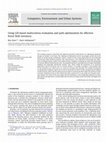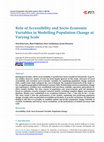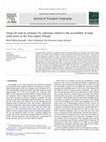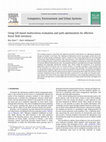Papers by Harri Antikainen
Nordia Geographical Publications, 2013

Computers Environment and Urban Systems, Mar 1, 2010
The inventory practices concerning non-industrial privately owned forests are undergoing signific... more The inventory practices concerning non-industrial privately owned forests are undergoing significant changes in Finland. In the future, the collection of information will be increasingly carried out by the means of remote sensing technologies, which is bound to have strong implications for the traditional and extensive field inventory practices. This study presents a new method for determining the importance of individual forest stands to the field inventory, including a technique for using this information to calculate efficient field inventory tours. The proposed method is essentially based on expert knowledge modeling and Geographic Information Systems (GIS), which enable the production of an inventory importance map for any forest area. In a similar fashion, it is possible to produce a traversability map for the particular area, which serves as a basis for inventory tour planning. The method incorporates an optimization technique, which can be used to determine the forest stands encompassing the highest overall inventory utility and the optimal traversal path for inventorying them under the presence of time constraint. Preliminary tests on the method have been carried out in a case study area located in Kuortane, Finland. The results of the tests suggest that the method has a lot of application potential, but more information and experience is needed about the new forest inventory system for further development of the method.

Scandinavian Journal of Trauma, Resuscitation and Emergency Medicine, 2015
Emergency medical services are an important part of trauma care, but data comparing urban and rur... more Emergency medical services are an important part of trauma care, but data comparing urban and rural areas is needed. We compared 30-day mortality and length of intensive care unit (ICU) stay for trauma patients injured in rural and urban municipalities and collected basic data on trauma care in Northern Finland. We examined data from all trauma patients treated by the Finnish Helicopter Emergency Medical Services in 2012 and 2013. Only patients surviving to hospital were included in the analysis but all pre-hospital deaths were recorded. All data was retrieved from the national Helicopter Emergency Medical Services database, medical records, and the Finnish Causes of Death Registry. Patients were defined as urban or rural depending on the type of municipality where the injury occurred. A total of 472 patients were included. Age and Injury Severity Score did not differ between rural and urban patients. The pre-hospital time intervals and distances to trauma centers were longer for rural patients and a larger proportion of urban patients had intentional injuries (23.5% vs. 9.3%, P <0.001). The 30-day mortality for severely injured patients (Injury Severity Score >15) was 23.9% in urban and 13.3% in rural municipalities. In the multivariate regression analysis the odds ratio (OR) for 30-day mortality was 2.8 (95% confidence interval 1.0 to 7.9, P = 0.05) in urban municipalities. There was no difference in the length of ICU stay or scores. Twenty patients died on scene or during transportation and 56 missions were aborted because of pre-hospital death. The severely injured urban trauma patients had a trend toward higher 30-day mortality compared with patients injured in rural areas but the length of ICU stay was similar. However, more pre-hospital deaths occurred in rural municipalities. The time before mobile ICU arrival appears to be critical for trauma patients' survival, especially in rural areas.

Environmental Health Perspectives, 2015
Despite the recent developments in physically- and chemically- based analysis of atmospheric part... more Despite the recent developments in physically- and chemically- based analysis of atmospheric particles, no models exist for resolving the spatial variability of pollen concentration at urban scale. We developed land use regression (LUR) approach for predicting spatial fine-scale allergenic pollen concentrations in the Helsinki Metropolitan Area, Finland, and evaluated the performance of the models against available empirical data. We utilized grass pollen data monitored at 16 sites in an urban area during the peak pollen season and geospatial environmental data. The main statistical method was generalized linear model (GLM). GLM based LURs explained 79% of the spatial variation in the grass pollen data based on all samples, and 47% of the variation when samples from two sites with very high concentrations were excluded. In model evaluation, prediction errors ranged from 6% to 26% of the observed range of grass pollen concentrations. Our findings support the use of geospatial data-based statistical models to predict the spatial variation of allergenic grass pollen concentrations at intra-urban scales. A remote sensing based vegetation index was the strongest predictor of pollen concentrations for exposure assessments at local scales. LUR approach provides new opportunities to estimate the relations between environmental determinants and allergenic pollen concentration in human-modified environments at fine spatial scales. The presented approach could potentially be applied to estimate retrospectively pollen concentrations to be used for long-term exposure assessments.

Lecture Notes in Computer Science, 2004
Environmental information systems (EIS) have been in professional use for quite a long time. Appl... more Environmental information systems (EIS) have been in professional use for quite a long time. Applications of this domain often include features of quite common location based services (LBS). This means utilization of space-, time-and content-oriented data for positioning and routing services with various maps. Firstly, new integrated technology and lower prices of related technology have made it possible for users to benefit from new mobile services with reasonable cost. Secondly, new kinds of ambient aware applications are active research and development topics. We define mobile environmental information systems (MEIS) as integrated mobile information systems used to study, monitor and exploit the nature as well as to guide users like tourists and biologists in the nature. In this paper we present our research in progress, where we have built the first MEIS prototype to be used as a basis for MEIS services that exploit LBS and ambient awareness. The main purpose of this experiment has been to explore the technologies and methods for efficient building of easily extendable mobile platforms that would support main MEIS functionalities. According to our literature survey no similar technical solution as a mobile phone service did not exist.
Annales Zoologici Fennici, 2015

Journal of Geographic Information System, 2014
During past decades, effects of accessibility to growth have been considered extensively. In prev... more During past decades, effects of accessibility to growth have been considered extensively. In previous studies, however, matter of scale has been largely ignored. In this study, relevance of travel accessibility and essential socio-economic variables for explaining population change analysed with a multi-scalar study setting by the case of Finland. The analytical framework of the study relies on applied geographical information systems (GIS). Relationships between population change and explanatory variables were established with non-linear multiple regression, generalised additive models (GAMs). The data consist of population and socio-economic grid cell databases based on authentic records, transport network models, including complete digital road network database. Models were established at six resolutions between 2 km × 2 km and 24 km × 24 km. The main result is that the performance of the models, explaining and predicting population change, strongly relies on potential accessibility particularly at accurate resolutions. An important finding is also that it is possible to establish explain and predict population change tolerably at accurate resolutions and well at coarse resolutions, as the performance of models increases with scale.
Journal of Animal Ecology, 2015
1. Metacommunity research relies largely on proxies for inferring the effect of dispersal on loca... more 1. Metacommunity research relies largely on proxies for inferring the effect of dispersal on local community structure. Overland and watercourse distances have been typically used as such proxies. A good proxy for dispersal should, however, take into account more complex landscape features that can affect an organism's movement and dispersal. The cost distance approach does just that, allowing determining the path of least resistance across a landscape.

Journal of Transport Geography, 2011
Everyday traffic accounts for a significant share of overall greenhouse gas emissions, in particu... more Everyday traffic accounts for a significant share of overall greenhouse gas emissions, in particular carbon dioxide (CO 2 ). While several solutions have been proposed for decreasing the emissions, a new kind of land use planning is required in order to achieve long-term effects. This study focuses on the effect of large retail store locations in the urban structure on overall CO 2 emissions, by using the Oulu region, Finland, as a case study. The aim was to utilize GIS tools to assess store locations in terms of CO 2 emissions from private cars used for consumer traffic. In this case, not only are the locations of the existing and planned retail units investigated with respect to population distribution and car ownership, but the analysis is also carried out by regarding any location within the study area as a hypothetical site for a large retail unit. According to the applied method, CO 2 values are lowest near the centre of the studied region, the region with the highest population density, although the city centre itself did not turn out to be the most optimal location for a retail store in terms of CO 2 emissions. Nevertheless, by generally reducing trip length, a compact urban structure is an important way of achieving long-term cuts in CO 2 emissions.

Journal of Transport Geography, 2011
This study analyzes the relation of accessibility by road and railway network to population chang... more This study analyzes the relation of accessibility by road and railway network to population change between the years 1970-2007 in Finland. Accessibility is evaluated at built-up area unit and municipal levels by potential accessibility analysis and by measuring accessibility to network. Analyses are done in decadal periods by using geographical information systems (GIS) and data about road and railway networks involving digitized speed limits and geometry for each period. Accessibility variables and population change are related by generalized additive models (GAMs). The results indicate that the Finnish population has concentrated to areas with high road-based potential accessibility, especially since the opening in the Finnish economy in the 1990s. The accessibility of railway network was found to have affected the population change in the 1970s, when local level traffic reduced in the entire country, and in 2000-2007, following remarkable investments in long-haul transport.
Journal of Interdisciplinary History, 2011
Analysis based on historical geographical information systems (hgis) databases can be used to tra... more Analysis based on historical geographical information systems (hgis) databases can be used to trace the relationship between railway infrastructure and population change in Finland from 1880 to 1970. The use of accessibility calculations, statistical analyses, and gis reveals that Finland's population was almost evenly distributed in 1880, when railway development began, but that immigration to cities was well underway by

The Geographical Journal, 2012
The matter of scale is often ignored when analysing accessibility and its effects on population c... more The matter of scale is often ignored when analysing accessibility and its effects on population change. While accessibility has a concentrating effect on the activities of society on a regional scale, it also has a decentralising effect within urban areas in developed countries, including Finland. Population change is the outcome of numerous individual location choices. However, the scale on which these choices form a pattern related to transport accessibility is unclear, because the increasing stochasticity in an accurate resolution forces consideration of the effect of accessibility on population dynamics in the context of local characteristics. The matter of scale on modelling the relationship between transport accessibility and population change is considered in this article by comparing results using six different resolutions: namely side lengths of grid cells involving 2, 4, 8, 12, 16 and 24 kilometres. Road, air and rail accessibility were related to population change with non-linear regression, generalised additive models (GAM). Road accessibility was assessed by potentials originating from a gravity model. For revealing the effect on population change, air and rail accessibility were calculated as travel times to airports and stations. Analyses were based on exact population grid-cell data, an accurate model of road and rail networks and using geographical information systems (GIS). The study shows that population change was strongly related to potential accessibility. Airport accessibility also had high importance, whereas railway accessibility did not have any significant effect. The relevance of modelled relationships was noted to be clearly dependent on geographical scale. The models have good predictive ability at a 24 ¥ 24-km resolution, but in resolutions more accurate than 12 ¥ 12 km, much of the predictive power decreases. Our results strongly indicate that scale matters in accessibility analysis, and it should be taken into account in forthcoming population change studies.

Computers, Environment and Urban Systems, 2010
The inventory practices concerning non-industrial privately owned forests are undergoing signific... more The inventory practices concerning non-industrial privately owned forests are undergoing significant changes in Finland. In the future, the collection of information will be increasingly carried out by the means of remote sensing technologies, which is bound to have strong implications for the traditional and extensive field inventory practices. This study presents a new method for determining the importance of individual forest stands to the field inventory, including a technique for using this information to calculate efficient field inventory tours. The proposed method is essentially based on expert knowledge modeling and Geographic Information Systems (GIS), which enable the production of an inventory importance map for any forest area. In a similar fashion, it is possible to produce a traversability map for the particular area, which serves as a basis for inventory tour planning. The method incorporates an optimization technique, which can be used to determine the forest stands encompassing the highest overall inventory utility and the optimal traversal path for inventorying them under the presence of time constraint. Preliminary tests on the method have been carried out in a case study area located in Kuortane, Finland. The results of the tests suggest that the method has a lot of application potential, but more information and experience is needed about the new forest inventory system for further development of the method.
Nordia Geographical …, 2006
... Eriksson, O. (2002). Location Based Destination Information for the Mobile Tourist. In Wöber ... more ... Eriksson, O. (2002). Location Based Destination Information for the Mobile Tourist. In Wöber KW, Frew AJ, Hitz M. (eds.): Information and Communication Technologies in Tourism. Springer-Verlag. ... Creating Location Services for the Wireless Web. John Wiley & Sons, New York. ...

Cybernetics and Systems, 2004
This paper presents the foundations for building mobile environmental information systems (MEISs)... more This paper presents the foundations for building mobile environmental information systems (MEISs) requiring an interdisciplinary approach. MEISs require expertise from the disciplines of environmental biology, geography, and mobile technology. MEISs show great promise for the acquisition of 737 environmental information using different mobile devices. Automatic mobile acquisition enables the forwarding of the information to central databases for storage, further processing, and transmission to the mobile devices in a form that is useful to the users. Furthermore, these systems have the potential to be used both in the protection of nature, as well as in recreational use in a way that takes the constraints of nature into account. In this paper we describe the preliminary results of the MINNE project and the prototypes currently under research in the project.









Uploads
Papers by Harri Antikainen